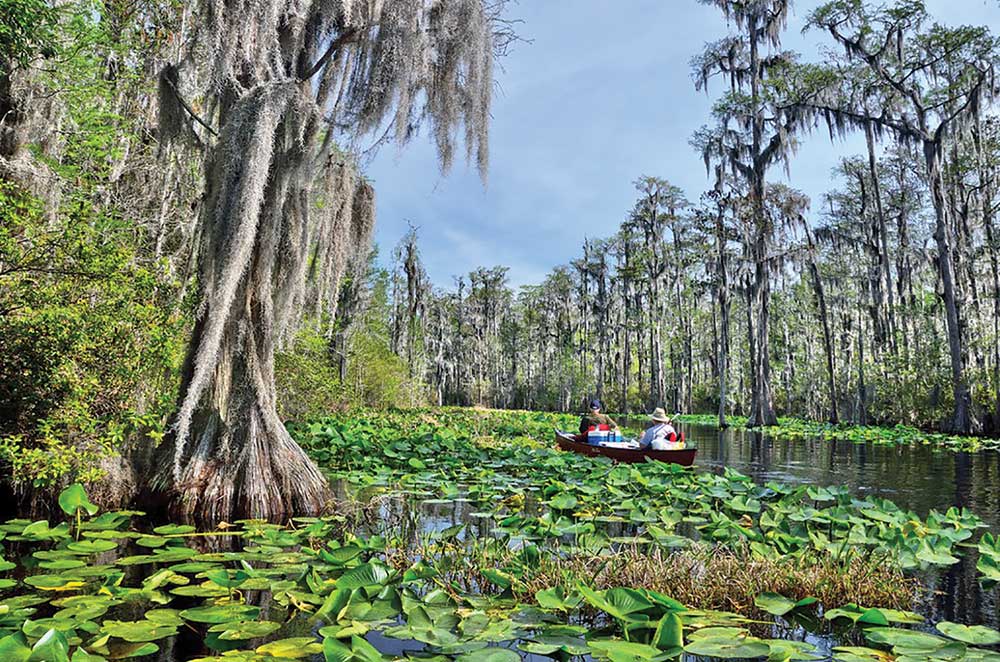Voice your opposition and concerns to Holly Ross at the Army Corps of Engineers:[email protected]
Mining company threatens the Okefenokee (again)
David Brower, one of the 20th century’s most influential environmentalists, once said that “when they win, it’s forever. When we win, it’s merely a stay of execution.”
After spearheading efforts to save several of our most iconic landscapes, such as Redwood and North Cascades National Parks, Brower came to understand that, even with formal protections, few green spaces are truly safe and must often be defended and secured more than once.
For the Okefenokee National Wildlife Refuge, that is indeed the case. Recently, Twin Pines Minerals, LLC, an Alabama-based company, took the first steps towards establishing what it hopes will become a 12,000-acre mine, located along the Southeastern refuge boundary. This is neither the first proposal of its kind nor is it likely to be the last.
At 438,000 acres, the Okefenokee swamp is a vast labyrinth of dripping cypress forests, pine islands, lily ponds, and blackwater channels, most of which are protected within the Okefenokee National Wildlife Refuge. Thousands of species, including the imperiled gopher tortoise and wood stork, call its unspoiled habitat home, as do upwards of 12,000 American alligators. Unlike most other North American wetlands of significance, such as the Everglades or Great Dismal Swamp, the function and health of the Okefenokee has not been compromised by development or agriculture, earning it the distinction as a Wetland of International Importance and a tentative UNESCO World Heritage Site.
Even though the refuge is legally protected, history has shown that the swamp is far from secure. Twenty years ago, the DuPont corporation set its sights on a deposit of titanium found along the so-called Trail Ridge, a natural earthen barrier that is responsible for ensuring that water is stored within and flows toward the swamp. Forming the eastern edge of the refuge, DuPont hoped to mine the Trail Ridge’s distinct layers of soil, mix them together, then dump them back into pits, likely compromising the swamp’s hydrological integrity. That project was ultimately killed by a tidal wave of opposition. It also sent a clear and unmistakable message to the mining industry: Okefenokee is off-limits.
Unfortunately, Twin Pines failed to heed this lesson and, in brazen defiance, has once more targeted the edge of the refuge for titanium mining. Over the course of 30 years, the company intends to strip the land of vegetation, mine to depths of 70 feet in some places, and destroy the soils that influence water retention within the swamp. The U.S. Fish and Wildlife Service has already warned that, should mining proceed in this manner, the damage to the entire refuge—a landscape it states is “like no other place on Earth…may be permanent.” Similar sentiments were expressed by expert hydrologists during the latest public comment period.
As the largest national wildlife refuge east of the Mississippi, the Okefenokee is of immense value to wildlife and humans alike. The refuge attracts 600,000 people annually, generates $64 million in local annual economic output, and supports over 700 local jobs. Offering unmatched opportunity for solitude and adventure, the swamp speaks to people in a manner that few places are able and represents one of the last true examples of the primitive South. Its hard-won wilderness character, however, is delicate and easily lost. According to refuge surveys, 50% of visitors indicated they’d be less likely to return for future visits were the swamp’s water quality or amount to diminish. As Twin Pines’ track record confirms, impacts of this nature are simply the cost of doing business.
In Florida, Twin Pines was recently cited in a consent order for failing to maintain silt fences and illegally discharging tailings into a wetland. In a cynical display of gamesmanship, the company furthermore misrepresented at local hearings both the size of the mining operation, as well as its potential impacts to threatened and endangered species. Twin Pines also claimed that “mining will not have an impact on the Okefenokee swamp,” yet has offered no definitive evidence to support their claim. Twenty years ago, similar promises prompted then-Secretary of the Interior, Bruce Babbitt, to declare that, no matter how many studies or models were produced, mining proponents would never be able to “prove beyond a reasonable doubt” that there would be no impact to the swamp. That was the case then and remains the case today.
The fight to protect the Okefenokee has a long and rich history, with activists struggling for a century to shield it from commercial exploitation. That effort came to what was thought its natural end in 1974, when roughly 350,000 acres were designated as federally protected Wilderness. At that time, no one predicted that mining would eventually become the most significant threat to ever face the Okefenokee, with the potential for lasting and permanent hydrological damage. At a minimum, we can be sure that, were the project to move forward, the sounds of cranes and storks would be overwhelmed by industrial machinery; the dark skies tainted by the glow of artificial lighting; the waters polluted by inevitable runoff; and the abundant wildlife that depends on the swamp diminished, spoiling the values for which the Okefenokee is world-renowned. It would also open the door for additional mining companies who’ve long coveted even larger properties along the refuge boundary.
The Okefenokee has been described as one of the 100 most beautiful places on the planet. Only public outcry will ensure the swamp forever remains that way. In the coming months, wildlife enthusiasts, hunters, paddlers, and recreationists of all types must unite against Twin Pines and stand once again in the Okefenokee’s defense.








